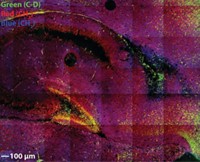Advertisement
Grab your lab coat. Let's get started
Welcome!
Welcome!
Create an account below to get 6 C&EN articles per month, receive newsletters and more - all free.
It seems this is your first time logging in online. Please enter the following information to continue.
As an ACS member you automatically get access to this site. All we need is few more details to create your reading experience.
Not you? Sign in with a different account.
Not you? Sign in with a different account.
ERROR 1
ERROR 1
ERROR 2
ERROR 2
ERROR 2
ERROR 2
ERROR 2
Password and Confirm password must match.
If you have an ACS member number, please enter it here so we can link this account to your membership. (optional)
ERROR 2
ACS values your privacy. By submitting your information, you are gaining access to C&EN and subscribing to our weekly newsletter. We use the information you provide to make your reading experience better, and we will never sell your data to third party members.
Biological Chemistry
Why The Long Fat?
Cancer Biochemistry: Mass spectrometry follows the metabolism of very long fatty acids in cancer cells
by Erika Gebel
October 25, 2011

Tumor cells ramp up the production of fatty acids to fuel their malignant growth. Cancer researchers want to understand the difference between fatty acid metabolism in these cells and that in healthy cells so that they can design treatments that target cancer cells.
But not all fatty acids are easy to study. Very-long-chain fatty acids, those containing more than 24 carbons, are extremely rare and the most elusive. Now researchers have developed a method to monitor the metabolism of these fatty acids in cells, offering a new way to study cancer cell biology, the researchers say (Anal. Chem., DOI: 10.1021/ac202220b).
Fatty acid metabolism is complex: Cells use multiple tightly-regulated pathways to synthesize and break down dozens of types of fatty acids. “We don’t know how all these different pathways work together,”says Jurre Kamphorst of Princeton University, or how cancer genes change their regulation. It’s particularly difficult to monitor how long-chain fatty acids change in cancer, he says, because conventional analytical methods rely on bulk measurements that often miss the rare molecules.
To determine where the elusive fatty acids come from and where they go, Kamphorst, Joshua D. Rabinowitz, and their colleagues developed a method that involves feeding cells 13C-labeled glucose and glutamine, two molecules that flow into fatty acid synthesis pathways. Using mass spectrometry, the researchers could piece together the cells’ metabolic pathways by spotting where the 13C landed in the cells’ fatty acid chains.
The researchers first cultured mouse kidney cells with the labeled molecules. The scientists then extracted the cells’ fatty acids to analyze by liquid chromatography-mass spectrometry. They picked this technique because it keeps fatty acids intact. The scientists could detect 45 different fatty acids with between 14 and 36 carbons per chain, and at concentrations as low as 5 ng/mL.
Fatty acids with the same length often had different 13C labeling patterns, the researchers found. Based on these patterns and knowledge of metabolic pathways, Kamphorst and his team could figure out which fatty acids were made from scratch, which had been elongated in the cell, and which had been absorbed from the surrounding environment.
To understand how fast-growing tumor cells satisfy their need for fatty acid production, the scientists also used their method to study mouse kidney cells expressing the gene ras, which promotes cancer cell growth. The researchers found that these cells had more long-chain fatty acids than did those without the gene, and that the cells produced this abundance by elongating fatty acids that they had absorbed from their surroundings.
Benjamin Cravatt of the Scripps Research Institute, calls the new fatty acid analysis method “a good solution,” to a problem in the metabolism field. He points out that the researcher’s experiment in which they analyzed how cells with cancer genes make long-chain fatty acids “wouldn’t be possible if you didn’t have this method.”



Join the conversation
Contact the reporter
Submit a Letter to the Editor for publication
Engage with us on Twitter